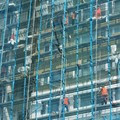Sylva Francová – Grey town
House of art Ústí nad Labem, Klíšská 1101/129a, Ústí nad Labem
September 6, 2018 - October 6, 2018
|
Sylva Francová – Grey townHouse of art Ústí nad Labem, Klíšská 1101/129a, Ústí nad LabemSeptember 6, 2018 - October 6, 2018
http://duul.cz/en/sylva-francova/
“Photography has the function of helping one to overcome the sorrow of the passing of time, either by providing a magical substitute for what time has destroyed, or by making up for the failures of memory, acting as a mooring for the evocation of associated memories (…)“ Pierre Bourdieu, Photography: A Middle-Brow Art The exhibition The Grey Town of Sylva Francová presents the artworks inspired by the Prague housing estate Jižní Město in which the author spent her childhood and a part of her life. “The housing estate has got deeply under my skin, I remember all the endless rows of windows on grey panels, concrete underpasses and pedestrian bridges, eerie ventholes from the tube, and the wind sweeping down the abandoned plains,” says Sylva Francová. The author captures the largest housing estate in the Czech Republic over a long period in time-lapse projects. These result in a series of pictures that reflect the atmosphere of a concrete urban area; sometimes anonymous, sometimes mysterious. They show us the ever-changing world, mirroring the changes in time, seasons, and activities and moods of local residents. The photobookwork The Grey Town is based on the memories of how the housing estate has been changing. In the book, place is perceived as an area undergoing unstoppable changes over time. Francová works not only with photographs taken recently but also with pictures stored in the family archive over the last 15 years. She focuses mainly on the appearance of the housing estate and the gradual changes. Working with the reality of everyday details, a mosaic is created in which it seems as if time stood still. Sylva Francová’s project Group Isolation captures various groups of people as well as lonely individuals. This project is presented both as an installation called Collection of People and as a photobookwork. It works with pairs of photographs on opposite sides, the first one captures the real situation and the second picture focuses on a selected resident taken out of the context. The group order, internally accompanied by a certain chaos and present movement, represents a collection of the author’s co-inhabitants. The subsequent focus on an individual refers to the person’s personal identity, hidden in the crowd. The long photo strip in the photobookwork The Pilgrims captures abandoned areas of the housing estate, with an occasional lonely pilgrim wandering the empty plains. The author chose the format of a concertina book, creating an illusive picture story about local residents.
|


